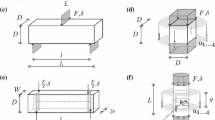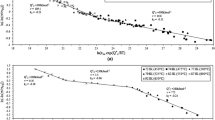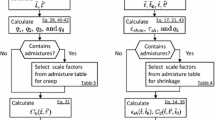Abstract
Experimental data from many creep test series are compared with predictions from various formulas in international codes. A mathematical simple creep formula is proposed and its accuracy is determined from comparison with the experimental data. Based hereon, a probabilistic model for the creep coefficient is proposed and the different sources of uncertainty are quantified. The proposed model is well suited for hand calculations.
Résumé
On a comparé plusiurs formules proposées dans les codes nationaux et internationaux pour la prévision du coefficient de fluage. On a trouvé que certaines formules donnaient des erreurs systématiques. La formule proposée par le CEB et la FIP dans le Code Modèle de1978 semble la meilleure. On donne une version légèrement modifiée de cette formule sous une forme mathématique simple. On propose, en s'appuyant sur cette formule, un modèle probabiliste de détermination du coefficient de fluage. On donne ensuite des valeurs moyennes et des variances pour le béton quelconque et les variables du milieu. On étudie de façon détaillée l'influence des variations d'humidité de l'air sur le coefficient de fluage à l'aide d'un modèle de diffusion simple. On démontre enfin que le modèle est bien adapté pour les calculs manuels et on calcule la valeur moyenne et la variation du coefficient de fluage sur un cas particulier.
Similar content being viewed by others
References
Cinlar E., Bažant, Osman E.—Stochastic process for extrapolating concrete creep, Journal of the Engineering Mechanics Division, Vol. 103, No. EM6, December 1977, pp. 1069–1088.
Jordaan J.,Discussion of [1] Closure by E. Cinlar, Z. Bažant, E. Osman.— Journal of the Engineering Mechanics Division, Vol. 105, No. EM3, June 1979, pp. 485–489.
Ditlevsen O., Madsen H. O.,On the uncertainty of concrete creep, InDIALOG 1-80, Department of Civil Engineering, Danish Engineering Academy, Lyngby, Denmark, 1980, pp. 127–172.
Joint Committee on Structural Safety, CEB-CECM-CIB-IABSE-RILEM:Basic notes on resistances, R-02 concrete properties Draft, 1981.
CEB-Recommandations pratique pour le calcul et l'exécution des ouvrages en béton précontraint, Bulletin d'Information No. 54, Paris, 1966.
CEB-FIP-International recommendations for the design and construction of concrete structures, Vol. 1, Information Bulletin No. 72, Paris, 1970.
CEB-FIP-Model Code for concrete structures, CEB Bulletin No. 124/125-E, Paris 1978.
German reinforced concrete code DIN 1045, Edition 1975.
German reinforced concrete code DIN 1045, Edition 1981.
German prestressed concrete code DIN 4277, Edition 1981.
ACI Committee 209/II.—Prediction of creep, shrinkage and temperature effects in concrete structures, ACI-SP27, American Concrete Institute, Detroit, 1971, pp. 51–93.
British Concrete Society.—A simplified method for estimating the elastic modulus and creep of normal weight concrete, Cement and Concrete Association Training Centre, TDH 7376, London, June 1978.
Bažant Z. andPanula L.—Creep and shrinkage characterization for analyzing prestressed concrete structures, PCI Journal, Prestressed Concrete Institute, Vol. 25, No. 3, May/June 1980.
Hilsdorf H. K. andMüller H. S.—Comparison of methods to predict time dependent strains of concrete, Institut für Baustofftechnologie, Universität Karlsruhe, October 1979.
Wesche K., Schrage I. and vonBerg W.—Versuche zum Einfluss des Belastungsalters auf das Kriechen von Beton, Deutscher Ausschuss für Stahlbeton, Heft 295, 1978.
Rüsch H., Kordina K. andHilsdorf H.—Der Einfluss des Mineralogischen Charakters der Zuschläge auf das Kriechen von Beton, Deutscher Ausschuss für Stahlbeton, Heft 146, 1962.
Hummel A., Wesche W. andBrand W.—Der Einfluss der Zementart, des Wasser-Zement-Verhältnisses und des Belastungsalters auf das Kriechen von Beton, Deutscher Ausschuss für Stahlbeton, Heft 146, 1962.
Kordina K.—Langzeitversuche an Stahlbetonstützen, Deutscher Ausschuss für Stahlbeton, Heft 250, 1975.
Wischers G. andDahms J.—Kriechen von frühbelasteten Beton mit hoher Anfangsfestigskeit, Sonderdruck aus Beton H 2 pp. 69–74, H3 pp. 104–108, 1977.
Wittmann F. andLucas J.—Rechnerische Erfassung von Kriechen und Schwinden des Betons (Zwischenbericht), Laboratorium für Werkstoffphysik der Technische Universität München, July, 1974.
Davis R.—Flow of concrete under sustained compressive stress, Proceedings American Concrete Institute, Vol. 24, 1928, pp. 303–335.
Rostasy F. S., Teichen K.-Th. andEngelke H.—Beitrag zur Klärung des Zusammenhanges von Kriechen und Relaxation bei Normalbeton, Otto-Graf-Institut Schriftenreihe, Heft 57, Universität Stuttgart, 1972.
Trost H., Cordes H. andGünther A.—Kriech-und Relaxations-versuche an sehr altem Beton, Deutscher Ausschuss für Stahlbeton, Heft 295, 1978.
Glanville W. H.—Studies in reinforced concrete III, the creep or flow of concrete under load, Department of Scientific and Industrial Research, Building Research Technical Paper, No. 12, London, 1930.
Bolomey J.—Déformation élastiques plastiques et de retrait de quelques bétons, Bulletin Technique de la Suisse romande, vol. 68, No. 15, 1942.
Dutron R.—Déformations lentes du béton et du béton armé sous l'action de charges permanentes, Annales de Travaux Publics de Belgique, Num. 37 de la 2. série, 1936/1937.
Weil G.—Influence des dimensions et des contraintes sur le retrait et le fluage du béton, RILEM Bulletin, No. 3, July 1959.
Ross A. D.—Concrete creep data, Structural engineer, Vol. 15, No. 8, 1937.
Ditlevsen O.—Uncertainly Modeling, McGraw-Hill, 1981.
Pat M. G. M. andReinhardt H. W.—Variability of creep of concrete-Analysis of the results, Delft University of Technology, Department of Civil Engineering, Report 5-80-8, Research No. 7802, December 1980.
Nielsen L. F.—On the prediction of rheological parameters for concrete, in DIALOG 1-80, Department of Civil Engineering, Danish Engineering Academy, Lyngby, Denmark, 1980, pp. 81–118.
Author information
Authors and Affiliations
Rights and permissions
About this article
Cite this article
Diamantidis, D., Madsen, H.O. & Rackwitz, R. On the variability of the creep coefficient of structural concrete. Mat. Constr. 17, 321–328 (1984). https://doi.org/10.1007/BF02479090
Issue Date:
DOI: https://doi.org/10.1007/BF02479090




